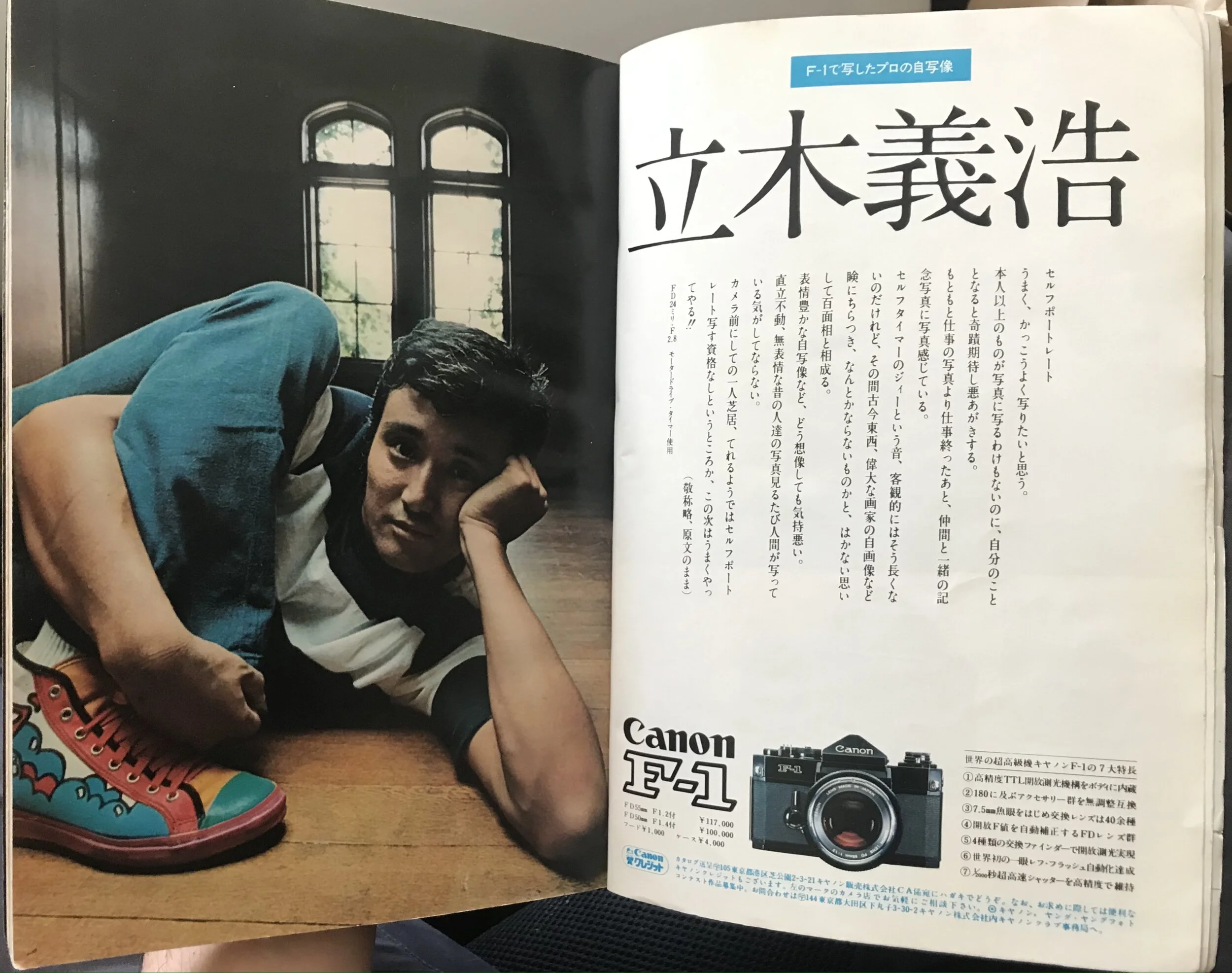A camera ad featuring a self-portrait by Tatsuki Yoshihiro, which ran in the Nov. 1972 supplementary issue of Asahi Camera.
If it wasn’t for the large type with the name Tatsuki Yoshihiro, I wouldn’t have known who is the young man in the photo. In the April 1965 issue of Camera Mainichi, over sixty pages were dedicated to Tatsuki’s photography. The feature was titled 舌出し天使 (translated to Fallen Angel) and focused on a young woman being emotive and playful for the camera. In many instances, she short crop and somewhat androdyous build make her seem that much younger. The original Japanese title shita dashi tenshi translates literally to an angel sticking out its tongue, which underscores better the youthful charge of the photography (as opposed to the more lyrical translation that was made at the time). As we discuss in our book Japanese Photo Magazines, for a woman to play-up childishness was not a simple matter of immaturity but possessed an undertone of revolt too. When that feature came out Tatsuki was only 28 years old and his career as a commercial photographer was only just starting to get its footing. Being young and energetic was part of his appeal for Camera Mainichi’s editor, Yamagishi Shōji.
When I was thumbing through this issue of Asashi Camera (November 1972), the first thing that popped into my head was the Fallen Angel photos and there is something about his funny pose that reminded me of his instructions to the model to act like a kid.
The text that accompanies this self-portrait is entirely about his discomfort in taking a self-portrait, which in today’s parlance would be close to a selfie. セルフタイマーのジーという音、客観的にはそう長くないのたけれど、その間古今東西、偉大な画家の自画像など瞼にちらつき、なんとかならないものかと、はかない思いして百面相と相成る。
The beep of the self-timer didn’t take very long in real time but, while I waited, self-portraits of great painters of all ages from all over the world flickered in my mind’s eye, and I wondered if there was anything I could do to compare. 表情豊かな自写像など、どう想像しても気持悪い。Expressive self-portraits are the pits by any stretch of the imagination.
This ad for the Canon F-1, which was marketed for professional photographers (or, rather, those aspiring to be professional photographers) offers us a slight view into what may have been happening during the shoot for Fallen Angel and the purpose of posing and posturing for the camera. It was silly because it pointed back to the lifeless and stiff composure of portrait painting. Photography, on the other hand, was a misbehaving imp. The double windows in the background are very unusual for Japan and I automatically assume that it was shot in Europe, which is a stark contrast to his pop-colored Converse shoes. (Maybe Rembrandt wore colorful Crocs when he painted his somber self-portrait as a mature man. We’ll never know.) Within context, photography in the late 60s and early 70s was a young man’s game and the name of that game was disruption. All the way at the very back of this issue, printed on uncoated stock that has yellowed considerably, there is a three-way dialogue between Taki Kōji, Nakahira Takuma, and Moriyama Daidō “The future of radicalism in expression.” (That was the reason why I bought this copy.)
If you are uncomfortable squinting, this is a transcription of the Japanese text:
セルフポートレート
うまく、かっこうよく写りたいと思う。
本人以上のものが写真にうつるわけもないのに、自分のこととなると奇跡期待し悪あがきする。
もともと仕事の写真より仕事終わったあと、仲間と一緒の記念写真に写真感じている。
セルフタイマーのジーという音、客観的にはそう長くないのたけれど、その間古今東西、偉大な画家の自画像など瞼にちらつき、なんとかならないものかと、はかない思いして百面相と相成る。
表情豊かな自写像など、どう想像しても気持悪い。
直立不動、無表情な昔の人達の写真見るたび人間が写っている気がしてならない。
カメラ前にしての一人芝居、てれるようではセルフポートレート写す資格なしというところが、この次はうまくやってやる!!

